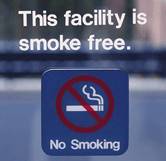
THURSDAY, Jan. 20 (HealthDay News) — A new report card gives the U.S. government relatively high marks for advances in treating people with tobacco-related illnesses, but gives low or failing grades to most states as their anti-smoking programs falter.
The report, from the American Lung Association, finds most states sorely lacking in efforts to get people to stop smoking or help them quit.
“We all can see that public sentiment is turning against smoking,” Charles D. Connor, president of the Association, said during a press conference Wednesday.
“However, it’s a grave mistake to assume that the shift in public thinking about tobacco means that the public health crisis has ended. It hasn’t,” he said.
Each year in the United States, 443,000 people die from illnesses directly related to tobacco use and exposure to secondhand smoke. This makes tobacco the number one cause of preventable deaths, Connor said.
Moreover, tobacco-related illness saps the country of more than $193 billion in health-care costs and lost productivity each year, he added.
“The tobacco companies, meanwhile, aren’t relenting in their campaigns of deception,” Connor said. “The industry found new ways in 2010 to market it products and target kids.”
Connor praised the federal government’s efforts to dissuade new smokers and help current smokers quit.
The U.S. Food and Drug Administration began overseeing tobacco products in 2009. So far, the agency has moved to ban the sale of cigarettes and smokeless tobacco to minors, to ban candy and fruit-flavored cigarettes, to prohibit tobacco industry sponsorship of sports and entertainment events, to take enforcement action against electronic cigarette markers, and to require larger health warnings on cigarettes and smokeless tobacco labels.
In addition, the new health care reform law expands programs to help people quit smoking. Most private health insurers will also have to offer treatments to help people quit, and under the Medicaid program, pregnant women will be able to get access to smoking cessation programs, according to the report.
The American Lung Association report card gave the FDA a ‘B’ for its anti-smoking efforts. But the federal government got a ‘C’ for failing to cover smoking cessation programs in all federal health care programs and a ‘D’ for not raising the federal tax on cigarettes. The government also racked up another ‘D’ for not ratifying the international Framework Convention on Tobacco Control treaty.
And don’t even get the ALA started on state lawmakers.
“Most of our states are failing miserably when it comes to combating tobacco-caused disease,” Connor said. “Despite collecting millions of dollars, and in some cases billions, in tobacco settlement dollars and excise taxes, most states are investing only pennies of those dollars to help smokers quit and keep kids from starting,” he said.
The report faults states for using revenues from tobacco taxes and the tobacco settlement money to balance their budgets instead of using that money to fund anti-smoking and quit-smoking programs. In addition, only six states raised tobacco taxes last year.
The report card grades include an ‘F’ for 40 states and the District of Columbia for not funding tobacco control programs at recommended levels and an ‘F’ for 37 states for not making smoking cessation programs part of Medicaid.
No state received straight A’s. Arkansas, Montana, Maine, Oklahoma and Vermont were the only states to get all passing grades, although Oklahoma had straight Ds. Alabama, Kentucky, Mississippi, Missouri, North Carolina, South Carolina, Virginia and West Virginia were given F’s across the board.
In addition:
- Alaska and North Dakota got an A for funding tobacco prevention and control programs at CDC-recommended levels.
- Thirty-seven states got F’s for not offering tobacco cessation treatments to Medicaid patients and state workers, and not making recommended investments in state quitlines.
- Five states got an A for excise taxes of $2.90 per pack or more.
- Kansas alone passed a strong smoke free air law in 2010; 27 states now have such laws.
Commenting on the report, Danny McGoldrick, vice president for research at the Campaign for Tobacco-Free Kids, said that “it demonstrates that while we have made great progress addressing tobacco use, we still have a long way to go.”
There has to be a continued effort to get states to raise tobacco taxes, fund quitting programs and pass smoke-free laws, he said.
“Where the states have really failed is in using their settlement dollars or their tax dollars to fund tobacco prevention programs,” McGoldrick said. “In fact, they have been cutting those programs dramatically. We know what happens when you do that: You get more kids smoking, fewer adults trying to quit and smoking rates go up.”
More information
For more information on smoking and how to quit, visit the U.S. Centers for Disease Control and Prevention.

